

The Latest
-

Did Patriots do David Andrews dirty? Curran, Perry react to his release
Tom E. Curran and Phil Perry react to the Patriots parting ways with veteran center David Andrews.
-

Minutemen and Jumbotrons: Previewing the Battle of Lexington's 250th anniversary
A major milestone in the history of America takes place next month in Massachusetts: The 250th anniversary of the battles at Lexington and Concord, on April 19. “This is where the shot was heard ’round the world, and we are so proud that we can host an event for the whole world to see,” Lexington Select Board Chairman Doug Lucente... -

Latest reports on Cooper Kupp's free agency, potential salary
Cooper Kupp reportedly is looking for a lot of money in his next contract after being released by the Rams earlier this week.
-

Why Carlton Davis is ‘excited' to play with Christian Gonzalez
The Patriots now have two very good cornerbacks after signing Carlton Davis on Day 1 of NFL free agency.
-

Rafael Devers changes tune on moving from third base to DH
Speaking to reporters for the first time since Feb. 17, Rafael Devers indicated he’ll willingly move from third base to designated hitter for the Red Sox in 2025.
-

Mass. State Police trooper accused of trading favor for sex act appears in court
A Massachusetts State Police trooper appeared in court and pleaded not guilty Thursday after being accused of proposing that he not have a driver’s car towed in Boston in exchange for a sex act.
-

Family of man stabbed to death outside apartment complex in Leominster files lawsuit
It’s been almost a year since 20-year-old Robert Wright-Day was stabbed to death outside an apartment complex in Leominster, Massachusetts. Three people were later charged in connection with the tragedy. Now, the family has come forward demanding justice and filing a lawsuit on behalf of their loved one’s estate. The lawsuit names the a... -

Car crashes into Medford lawn after driver's apparent medical emergency
A person is in critical condition after suffering an apparent medical emergency while driving a car in Medford, Massachusetts, on Thursday, police said.
-

Wife, sister of embattled Karen Read investigator Trooper Proctor speak out
The wife and sister of Massachusetts State Police Trooper Michael Proctor released statements saying that Karen Read’s lawyers have maligned Proctor’s character as a distraction from the case.
-

Will the sky be clear during Friday's lunar eclipse? Full ‘blood worm moon' projected for 3 a.m.
Our coolest day of the 10-day forecast is upon us. Temperatures remain in the low 40s at the coast with some 50s inland. Thanks to the consistent easterly breeze off the low 40 degree ocean water temps, it’s a brisk day at the shore. This also means moisture from the ocean will keep clouds around overnight during our lunar eclipse…. -

Seven takeaways from Celtics' entertaining seven-game homestand
What lessons should the Celtics take from recent clashes with the NBA’s elite? Chris Forsberg shares his thoughts from an action-packed homestand.
-

NBA playoff race: Most likely Celtics opponents in first round
At least three teams have a real chance to earn the No. 7 seed and play the Celtics in the first round of the 2025 NBA playoffs.









